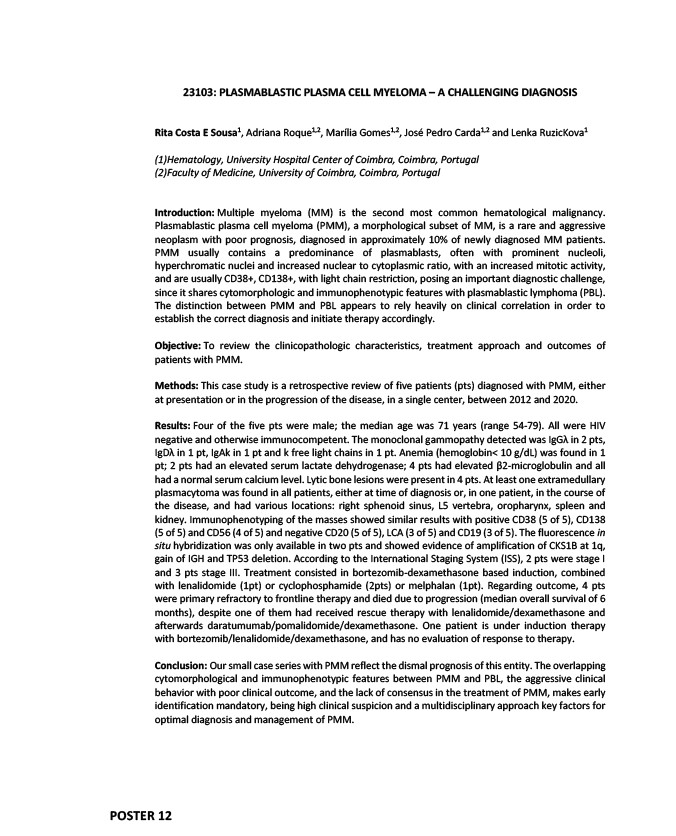
POSTER 12
23103: PLASMABLASTIC PLASMA CELL MYELOMA – A CHALLENGING DIAGNOSIS
Rita Costa E Sousa1, Adriana Roque1,2, Marília Gomes1,2, José Pedro Carda1,2 and Lenka RuzicKova1
(1)Hematology, University Hospital Center of Coimbra, Coimbra, Portugal
(2)Faculty of Medicine, University of Coimbra, Coimbra, Portugal
Introduction: Multiple myeloma (MM) is the second most common hematological malignancy.
Plasmablastic plasma cell myeloma (PMM), a morphological subset of MM, is a rare and aggressive
neoplasm with poor prognosis, diagnosed in approximately 10% of newly diagnosed MM patients.
PMM usually contains a predominance of plasmablasts, often with prominent nucleoli,
hyperchromatic nuclei and increased nuclear to cytoplasmic ratio, with an increased mitotic activity,
and are usually CD38+, CD138+, with light chain restriction, posing an important diagnostic challenge,
since it shares cytomorphologic and immunophenotypic features with plasmablastic lymphoma (PBL).
The distinction between PMM and PBL appears to rely heavily on clinical correlation in order to
establish the correct diagnosis and initiate therapy accordingly.
Objective: To review the clinicopathologic characteristics, treatment approach and outcomes of
patients with PMM.
Methods: This case study is a retrospective review of five patients (pts) diagnosed with PMM, either
at presentation or in the progression of the disease, in a single center, between 2012 and 2020.
Results: Four of the five pts were male; the median age was 71 years (range 54-79). All were HIV
negative and otherwise immunocompetent. The monoclonal gammopathy detected was IgGλ in 2 pts,
IgDλ in 1 pt, IgAk in 1 pt and k free light chains in 1 pt. Anemia (hemoglobin< 10 g/dL) was found in 1
pt; 2 pts had an elevated serum lactate dehydrogenase; 4 pts had elevated β2-microglobulin and all
had a normal serum calcium level. Lytic bone lesions were present in 4 pts. At least one extramedullary
plasmacytoma was found in all patients, either at time of diagnosis or, in one patient, in the course of
the disease, and had various locations: right sphenoid sinus, L5 vertebra, oropharynx, spleen and
kidney. Immunophenotyping of the masses showed similar results with positive CD38 (5 of 5), CD138
(5 of 5) and CD56 (4 of 5) and negative CD20 (5 of 5), LCA (3 of 5) and CD19 (3 of 5). The fluorescence in
situ hybridization was only available in two pts and showed evidence of amplification of CKS1B at 1q,
gain of IGH and TP53 deletion. According to the International Staging System (ISS), 2 pts were stage I
and 3 pts stage III. Treatment consisted in bortezomib-dexamethasone based induction, combined
with lenalidomide (1pt) or cyclophosphamide (2pts) or melphalan (1pt). Regarding outcome, 4 pts
were primary refractory to frontline therapy and died due to progression (median overall survival of 6
months), despite one of them had received rescue therapy with lenalidomide/dexamethasone and
afterwards daratumumab/pomalidomide/dexamethasone. One patient is under induction therapy
with bortezomib/lenalidomide/dexamethasone, and has no evaluation of response to therapy.
Conclusion: Our small case series with PMM reflect the dismal prognosis of this entity. The overlapping
cytomorphological and immunophenotypic features between PMM and PBL, the aggressive clinical
behavior with poor clinical outcome, and the lack of consensus in the treatment of PMM, makes early
identification mandatory, being high clinical suspicion and a multidisciplinary approach key factors for
optimal diagnosis and management of PMM.